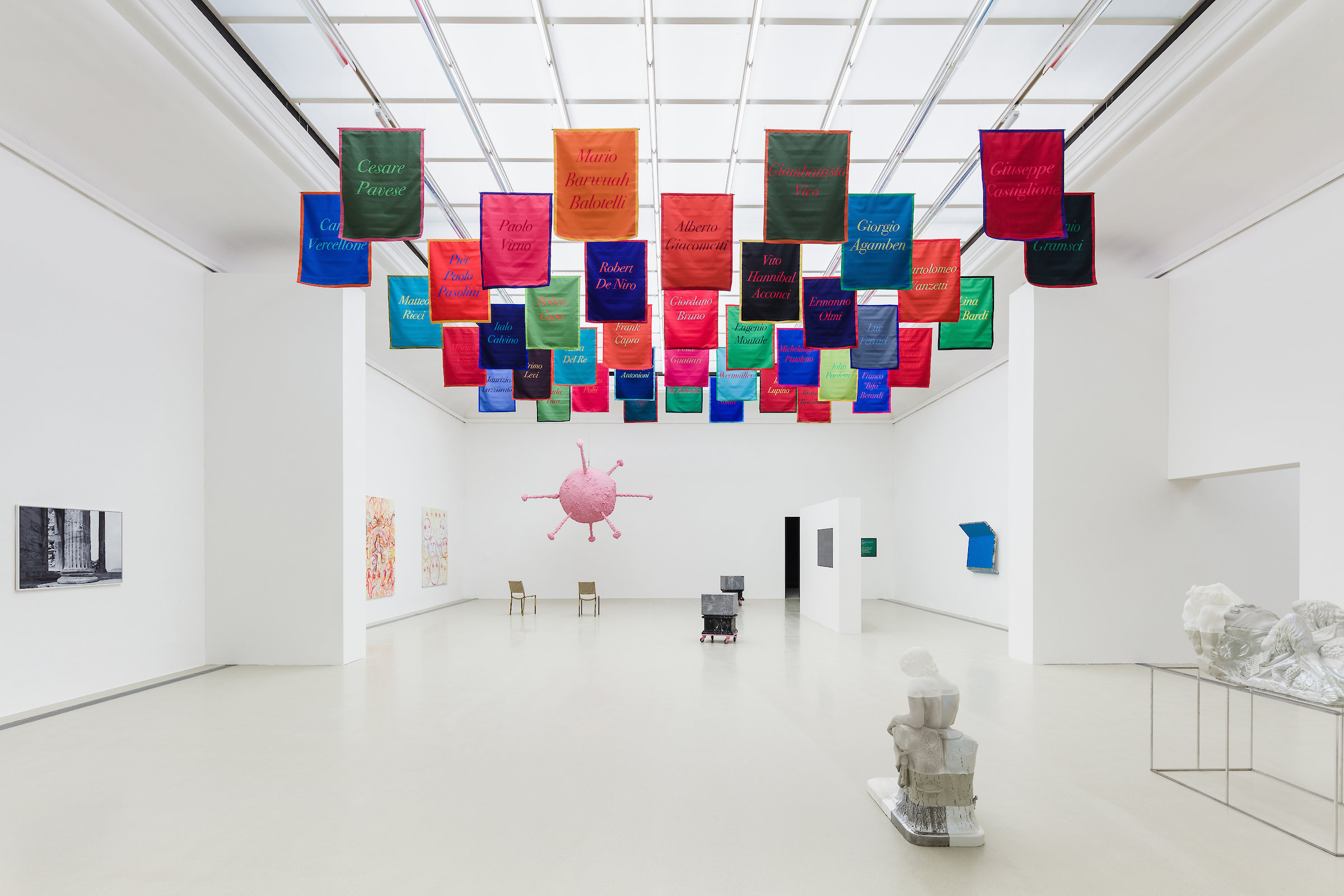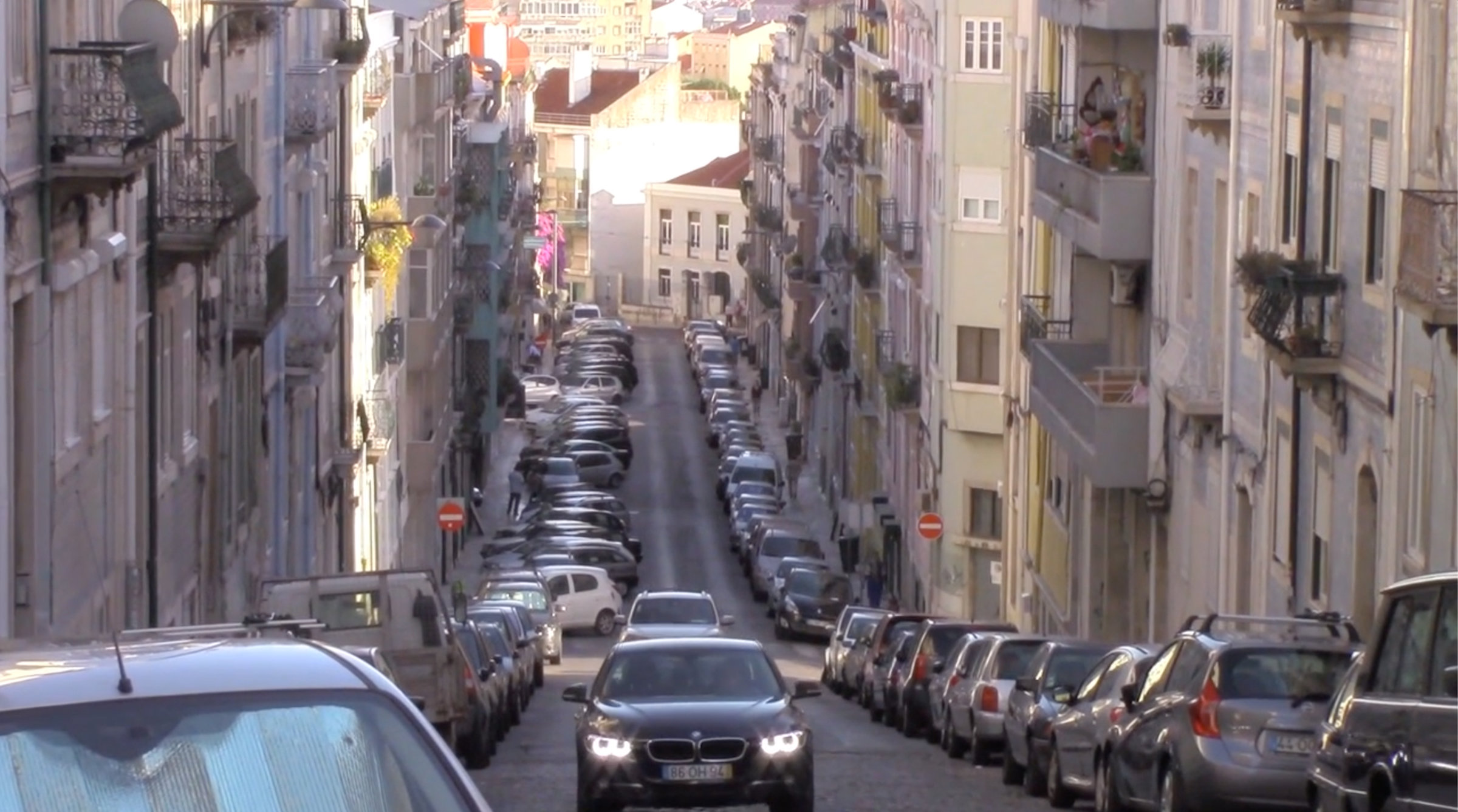Renée Green

Space Poem #4, 2013
Forty double-sided banners
Aquajet ProDisplay
Each 55.9 × 44.5 cm
Courtesy the artist, FAM, and Bortolami Gallery, New York; Photo: kunst-dokumentation.com
Renée Green (*1959 Cleveland, lives in New York) has been known since the 1990s above all for her complex installations for which she uses various media — primarily film, text, and architectural elements. She pursues a context-sensitive and critical approach that dissociates itself from the production of the objects and instead makes it possible to understand art as research-based work.
From 2007 Green has been working on and off on a multipart series of installations titled Space Poems. These installations are characterized by fabric banners in brilliant colors hanging above the heads of the visitors and printed with texts. The artist separates language from its ordinary context and uses it as reference material that she subjects to a spatial, graphic, and color recontextualization. The linguistic material thus becomes part of a poetic system and opens up viewers to a spatial situation in which they can use the gaps between the expressions for themselves.
In the installation Space Poem #4, the artist employs forty double-sided banners bearing Italian names. The names are those of famous personalities from various fields, such as the sciences, literature, philosophy, the visual arts, and film. But what do these names represent within the work? To get at the artist’s intention, it helps to consider the original context of the installation.
Space Poem #4 was created in 2013 in the context of an exhibition in a stately classical building in Rome that presented the artists shown as “representatives” of the city of New York. Green’s contribution can be seen as a critique of the whole premise which reduces the artists to their origin and in which they, like the symbolic status of the architecture, serve to express a nationalist consciousness. For whereas one’s initial impression of the names is that they are those of Italians by birth, it turns out that this is false. It quickly becomes clear that they have Italian names but are part of an Italian diaspora. Green is thus alluded to ideological restrictiveness concerning the theme of origin and counters it with the power of cultural diversity and pluralism. She also points out that cultural achievements are not tied to a specific nation.

Walking in NYL, 2016
Digital film, color, sound
44:20 min.
Director: Renée Green
Production: Free Agent Media
Courtesy the artist, FAM, and Bortolami Gallery, New York
The work’s title, Walking in NYL, refers to the cities of New York and Lisbon. Green’s digital film weaves various shots the artist made during forays through those two cities.
Renée Green lives primarily in New York and has a personal connection to Lisbon. She has dedicated several videos to her interest in the city of Lisbon, the earliest of them dating from 1992, part of her extensive project Tracing Lusitania. The project’s title exemplifies Green’s historical approach: Lusitania was the name of a Roman settlement that corresponds roughly to today’s Portugal. This implies that Green’s study is interested in themes such as the settlement of territories, the meeting of cultures, and the intertwining of present and past. Special attention is paid to colonial relationships.
For Green, one important link between the colonial past and the cultural present of the Americas and Europe is the historical figure of Christopher Columbus, who played a controversial role in the history of the American continents, and whose “discovery” of the Americas was being celebrated in 1992. Another important interest for her is the conquest of the African continent by the Portuguese in 1415. All of this merely resonates subtly in the background of the video Walking in NYL (2016), for example, when the artist is moving through the streets of New York or points her camera at dilapidated houses and structures in a residential neighborhood in Lisbon. The hidden connections between the past and the present seem almost to force themselves on us here.
The artist refers to New York and Lisbon as “cities by the water,” thus focusing on sea travel and the associated transportation of people and goods. For this topic, Green connects various historical aspects to the present: streets in Lisbon named after African countries, religious processions on the streets of New York, people of different skin colors shown constantly moving. All these suggestions give a sense of the complicated makeup of cultures. Green looks at how historical relationships live on in the present, as well as at transnational connections between cities, pointing towards the hybrid essence of cultural identity.
Renée Green
has exhibited her work in selected solo shows at Galería Visor, Valencia; Yerba Buena Center for the Arts, San Francisco; Musée cantonal des Beaux-Arts de Lausanne, Lausanne; Galerie nationale du Jeu de Paume, Paris; Galerie Christian Nagel, Berlin; Einstein Spaces, Berlin; Kunstraum Innsbruck, Innsbruck; Baltimore Museum of Art, Baltimore; and the Museum of Contemporary Art, Los Angeles.
Green has been in group exhibitions at Museum Ludwig, Cologne; IG Bildende Kunst, Vienna; Kunsthaus Graz, Graz; Manifesta 7 Trentino – Alto Adige 2008, Trentino; Foundation Manifesta, South Tyrol; Akademie der Künste, Berlin; Documenta XI, Kassel; the Haus der Kunst, Munich; the Museum Ludwig, Cologne; the Barcelona Centre Georges Pompidou, Paris; the Secession, Vienna; the MOCA, Los Angeles; the Bronx Museum of Art, New York; the Deichtorhallen, Hamburg; and the Louisiana Museum of Art, Copenhagen.